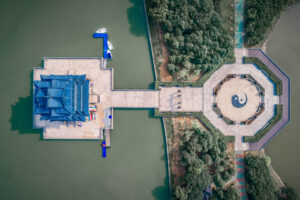In a world facing rapid urban growth and increasing climate unpredictability, efficient water management is more critical than ever. At the core of any city’s sustainability efforts lies a vital yet often overlooked system the water networks. It is this network that ensures every home, industry, and farm receives the clean water it needs while also managing wastewater disposal responsibly.
But the traditional water network model is becoming outdated. Enter smart technologies, data-driven insights, and next-generation platforms like those developed by Turing designed to transform aging infrastructure into intelligent, resilient water systems.
In this blog, we’ll explore how modern water networks work, why they matter, what challenges they face, and how innovative solutions from companies like Turing are reshaping the future of water infrastructure.
What Is a Water Network?
A water network refers to the interconnected infrastructure that manages the flow of water from its natural source to its destination be it residential, commercial, or agricultural and eventually back into the environment or reuse systems. This system typically includes:
-
Water sources (rivers, lakes, aquifers)
-
Treatment plants
-
Storage facilities
-
Pumping stations
-
Distribution pipelines
-
Sewer and drainage lines
-
Monitoring and control equipment
Together, these components form the foundation of how water is distributed, monitored, and treated in any community.
Why Water Networks Matter
Water is a basic human right and a key component of sustainable development. A well-functioning water network:
-
Ensures safe drinking water for populations
-
Supports agriculture and industry
-
Helps manage wastewater and stormwater
-
Reduces health risks from contaminated or stagnant water
-
Builds resilience against droughts, floods, and infrastructure failures
In short, without a strong water network, public health, environmental quality, and economic growth are all at risk.
The Current Challenges of Water Networks
Despite their importance, many water networks around the world suffer from inefficiency, outdated technology, and resource waste.
Key challenges include:
-
Aging Infrastructure
Many water systems rely on pipes and facilities installed decades ago. As these systems deteriorate, the risk of leaks, bursts, and service interruptions grows. -
Water Loss (Non-Revenue Water)
A staggering percentage of clean water is lost due to leakage, theft, and meter inaccuracies often reaching up to 30–40% in some cities. -
Manual Operations
Without automation and data analytics, water systems can’t respond quickly to issues like pressure drops, contamination, or irregular usage. -
Regulatory Compliance
Meeting safety and environmental standards is difficult without accurate, real-time data. -
Urbanization and Climate Change
Growing populations and unpredictable weather patterns increase demand and strain on existing networks.
Turing’s Approach to Smart Water Networks
Turing offers modern, intelligent solutions that transform outdated water infrastructure into smart water networks. These solutions combine IoT technology, real-time monitoring, automation, and data analytics to streamline operations and improve water delivery across every node in the network.
Turing’s smart water network software offers:
-
Real-Time Leak Detection: Minimize losses and act instantly on network failures.
-
Remote Monitoring and Control: Operate pumps, valves, and pressure zones from anywhere.
-
Predictive Maintenance: Forecast pipe or system failures before they happen.
-
Data-Driven Decision Making: Analyze flow rates, pressure, and usage for more strategic planning.
-
Energy Optimization: Reduce power consumption and operational costs.
-
Customer Metering Integration: Improve billing accuracy and user transparency.
With Turing, water utilities gain complete visibility into their network, enabling faster decisions, better service, and long-term savings.
Benefits of Smart Water Networks
Investing in smart water technology brings powerful benefits for cities, municipalities, and private sectors:
1. Reduced Water Loss
Smart systems can detect leaks as they happen, allowing utilities to respond immediately—saving both water and money.
2. Increased Operational Efficiency
Automation and real-time monitoring minimize the need for manual inspection and reduce downtime.
3. Improved Customer Service
Smart meters and usage dashboards let consumers track their consumption and billing in real-time.
4. Regulatory Compliance
Detailed data logs and reports make it easier to meet government and environmental standards.
5. Sustainability
Efficient water use reduces environmental impact, especially important in drought-prone regions.
Real-World Applications
Turing’s water networks software can be applied across various sectors:
-
Urban Municipalities: Improve distribution efficiency and expand service coverage.
-
Industrial Complexes: Monitor water quality and usage in manufacturing processes.
-
Agriculture: Control irrigation systems with precision to reduce waste.
-
Disaster Preparedness: Identify areas prone to flooding or system failure in advance.
Getting Started with Turing’s Water Network Solution
If your city, organization, or utility is ready to upgrade its water infrastructure, Turing makes the process seamless:
-
Assessment: Evaluate your current system, identify challenges, and set goals.
-
Implementation: Install sensors, integrate software, and connect control systems.
-
Training: Equip your team with the tools and knowledge to manage the new system.
-
Optimization: Use real-time data and analytics to continuously improve network performance.

FAQs – Water Network
Q1: What is the difference between a water network and a water distribution system?
A water network encompasses the full water cycle source, treatment, distribution, and wastewater while a distribution system typically focuses on the delivery of clean water to end users.
Q2: Can smart water networks prevent water theft?
Yes. Turing’s real-time monitoring systems can detect irregular usage patterns that may indicate theft, helping reduce non-revenue water.
Q3: Is Turing’s solution scalable for small towns?
Absolutely. Turing’s modular design allows utilities to start small and expand over time, making it ideal for both rural and urban areas.
Q4: How quickly can a smart water network show ROI?
Many utilities start to see operational savings and reduced water loss within the first 12–18 months of implementation.
Q5: Does Turing offer support and maintenance post-installation?
Yes. Turing provides full-service support, including software updates, training, and technical assistance to ensure long-term success.
Conclusion
The water network is the invisible engine powering every home, city, and industry. But to meet the demands of the future, it needs to be smarter, more responsive, and more resilient.
With Turing’s intelligent water network solutions, utilities can transition from reactive maintenance to proactive management, significantly improving efficiency, safety, and sustainability. Whether your goal is to reduce water loss, cut operational costs, or ensure compliance, Turing delivers a future-ready system tailored to your needs.


